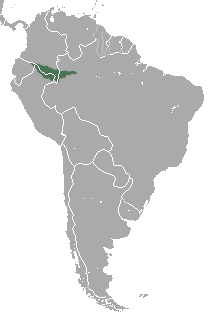| Lucifer titi | |
|---|---|
 | |
| Scientific classification | |
| Kingdom: | Animalia |
| Phylum: | Chordata |
| Class: | Mammalia |
| Order: | Primates |
| Suborder: | Haplorhini |
| Infraorder: | Simiiformes |
| Family: | Pitheciidae |
| Genus: | Cheracebus |
| Species: | C. lucifer |
| Binomial name | |
| Cheracebus lucifer (Thomas, 1914) | |
 | |
| Lucifer titi range | |
| Synonyms | |
Callicebus luciferThomas, 1914 | |
The Lucifer titi monkey (Cheracebus lucifer) is a species of titi, a type of New World monkey, from South America. It is found in Brazil, Colombia, Ecuador, and Peru. It was described as Callicebus lucifer in 1914. [2] The Lucifer titi has previously been treated as part of C. torquatus , the collared titi. [2] [3]
